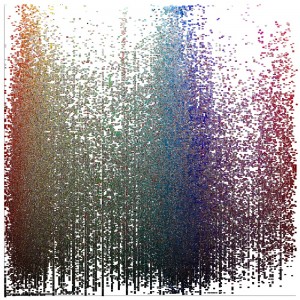 Most digital humanities approaches pursue traditional forms of scholarship by extracting a single variable from cultural texts that is already legible to scholars. Instead, this talk advocates a mostly-ignored “digital-surrealism” that uses computer-based methods to transform film texts in radical ways not previously possible. The return to a surrealist and avant-garde tradition requires a unique kind of research, which is newly possible now that humanists have made the digital turn. I take a surrealist view of the hidden in order to imagine what aspects of media texts are literally impossible to see without special computer-assisted techniques. What in the archive is in plain sight but still invisible? What in the cinema is so buried that our naked eyes are unable to see it? Here I present one such method, using the z-projection function of the scientific image analysis software ImageJ, to sum film frames in order to create new composite images. I examine four corpora of what would normally be considered rather different types of film: (1) the animated features produced by Walt Disney Animation Studios, (2) a representative selection of the western genre (including American and Italian “spaghetti” westerns), (3) a group of gialli (stylish horror films originating from Italy that influenced American slasher films), and (4) the series of popular Japanese Zatoichi films, following the adventures of the titular blind masseuse and swordsman living in 1830s Japan.
Most digital humanities approaches pursue traditional forms of scholarship by extracting a single variable from cultural texts that is already legible to scholars. Instead, this talk advocates a mostly-ignored “digital-surrealism” that uses computer-based methods to transform film texts in radical ways not previously possible. The return to a surrealist and avant-garde tradition requires a unique kind of research, which is newly possible now that humanists have made the digital turn. I take a surrealist view of the hidden in order to imagine what aspects of media texts are literally impossible to see without special computer-assisted techniques. What in the archive is in plain sight but still invisible? What in the cinema is so buried that our naked eyes are unable to see it? Here I present one such method, using the z-projection function of the scientific image analysis software ImageJ, to sum film frames in order to create new composite images. I examine four corpora of what would normally be considered rather different types of film: (1) the animated features produced by Walt Disney Animation Studios, (2) a representative selection of the western genre (including American and Italian “spaghetti” westerns), (3) a group of gialli (stylish horror films originating from Italy that influenced American slasher films), and (4) the series of popular Japanese Zatoichi films, following the adventures of the titular blind masseuse and swordsman living in 1830s Japan.
Kevin Ferguson is an Assistant Professor of English and Director of Writing at Queens College (CUNY). He teaches undergraduate and graduate courses on college writing, contemporary literature, and film adaptation.
[sign_up_sheet id=28]